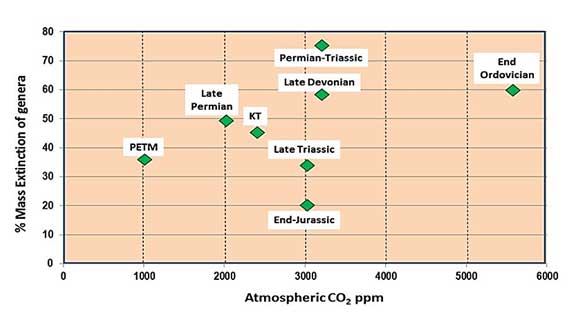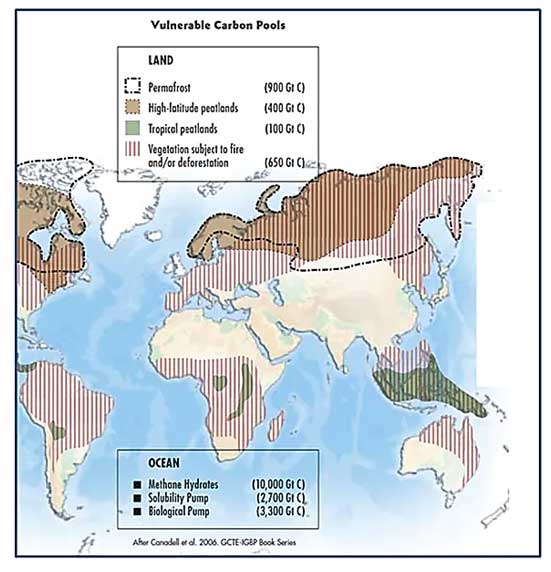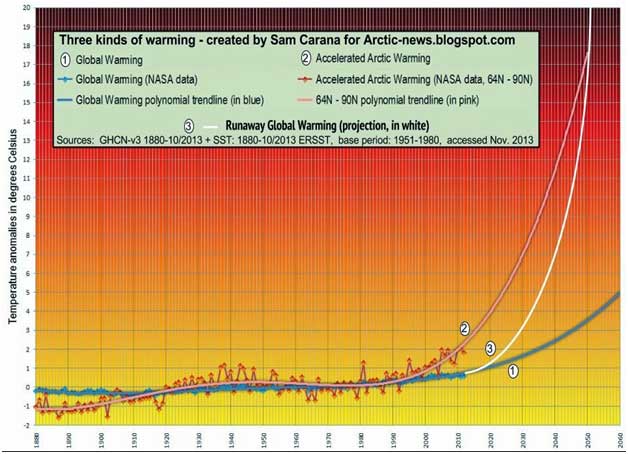Carbon, the essential element underpinning photosynthesis and life, is transformed into toxic substances in the remnants of plants and organisms buried in sediments. Once released to the atmosphere (Fig. 1) in the form of CO2, CO and methane, in large quantities these gases become lethal and have been responsible for mass extinctions of species (Fig. 2).
Given amplifying feedbacks from land and oceans triggered by rising temperatures, the concept of an upper limit of warming determined by limitation on carbon emissions alone is unlikely, since, under a rising high greenhouse gas concentration, amplifying feedbacks triggered by methane release (Fig. 1), bushfires, warming oceans and loss of reflectivity of melting ice, temperatures would keep rising. Recent findings show that warmer ocean water is melting crystallized methane and releasing it into the sediment and waters off the coast of Washington state, at levels that reach the same amount of methane from the Deepwater Horizon blowout.
Attempts at CO2 down-draw (sequestration), if urgently applied on a global scale, may conceivably be able to slow down further warming. This article refers to natural methane reservoirs and human induced methane emissions, indicating that, once temperatures supersede a critical level, a further rise in methane release would result regardless of restrictions of emissions.
According to Kelley (2003) a planetary “runaway greenhouse event” may be triggered when a planet overheats due to absorption of more solar energy than it can give off to retain equilibrium. As a result the oceans may boil filling its atmosphere with steam, which leaves the planet uninhabitable, as Venus is now. Planetary geologists think there is good evidence that Venus was the victim of a runaway greenhouse effect which turned the planet into the boiling hell we see today. According to Hansen (2012)“if we burn all reserves of oil, gas, and coal, there’s a substantial chance that we will initiate the runaway greenhouse”. In a critical review of the theory of the runaway greenhouse syndrome Goldblatt and Watson (2012) state: “We cannot therefore completely rule out the possibility that human actions might cause a transition, if not to full runaway, then at least to a much warmer climate state than the present one.”

Fig 1. A methane explosion crater in the Yamal region of Siberia
The concentration of fossil carbon deposits in the form of coal, oil, natural gas, coal seam gas, permafrost methane, ice clathrates, shale oil, and oil sands, once released to the atmosphere in large quantities, generates powerful feedbacks from land and ocean. This includes further release of greenhouse gases, warming oceans, loss of reflectivity of melting ice, and bushfires, pushing temperatures further upward. With greenhouse gas concentration rising at a rate of 2–3 parts per million (ppm) per year[1] and the Earth heating-up by 0.98oC since 1936, the ultimate consequences of this trend belong to the unthinkable.

Fig. 2Relations between CO2 levels in the atmosphere and mass extinctions of genera. Data cited from Royer et al. 2002 and from Keller 2005 and Wignall and Twitchett 2002
By 2012 total emissions are estimated to have reached 384 GtC, with an annual amount of 41.5 billion tonnes of carbon dioxide in 2018. According to the IPCC (2013) no more than 275 GtC of the world’s reserves of fossil fuels of 746 GtC can be emitted if global temperature rise is to be restricted to 2oC above pre-industrial temperatures, an impossible target since amplifying carbon feedbacks would push temperatures upwards.
According to Hansen et al. (2013) recoverable fossil fuel reserves include ~120 GtC gas, ~80 GtC oil, >10,000 GtC coal, >2000 GtC unconventional gas, ~700 GtC unconventional oil, totaling ~13,000 GtC (Fig. 3). According to Heede and Oreskes (2016)global reserves of oil (~171 GtC), natural gas (~95) and coal (479 GtC) totaling 746 GtC, are below Hansen et al.’s estimates.

Fig 3. Estimates suggest the possibility of near-or above 13,000 GtC of fossil fuel reserves (Hansen et al. 2013).
The amount of unstable methane deposits in permafrost (Fig. 4) and methane hydrates (clathrates) in ocean sediments (Fig. 5) is of a similar order of magnitude as the amount of fossil fuel reserves. This includes methane hydrates in sediments (~10,000 GtC), solubility and biological pump (~6000 GtC), Permafrost methane (~900 GtC), tropical peatlands and vulnerable vegetation (~750 GtC) (Fig. 4). Unoxidized metastable deposits of methane and methane hydrates, accumulated during the Pleistocene glacial-interglacial cycles and vulnerable to temperature rise, are already leaking as indicated by atmospheric concentration which have risen from 1988 (~1700 ppb CH4 ) to 2019 (~1860 ppb CH4 ) at a rate of ~5.2 ppb/year, which for radiative equivalent of X25CO2 reached more than 40 ppm CO2-equivalent.

Fig 4.Vulnerable carbon sinks. ( a ) Land permafrost ~ 600 GtC; High-latitude peatlands ~ 400 GtC; tropical peatlands ~100 GtC; vegetation subject to fire and/or deforestation ~ 650 GtC; ( b ) Oceans methane hydrates ~10,000 GtC;Solubility pump ~2700 GtC; Biological pump ~3300 GtC; total ~17,750 GtC

Fig 5a. Global distribution of methane hydrate deposits on the ocean floor.
Fig. 5b plumes of methane bubbling to the surface of the Arctic Ocean.
Fig 5c. Frozen methane bubbles at Abraham Lake, Alberta
Meinshausen et al. (2011) estimated global-mean surface temperature increases, applying a climate sensitivity of 3°C per doubling of CO2, affecting by 2100 a temperature rise between 1.5°C to 4.5°C relative to pre-industrial levels. By 2300, under constant emissions, CO2 concentration would rise to ~2000 ppm, methane to 3.5 ppm and nitrous oxide to 0.52 ppm (Fig. 6). Amplifying feedbacks are taken into account, but the effects of tipping points and of cold ice-melt pools formed in the oceans near Greenland and Antarctica ice sheets are unclear.

Fig 6.GHG concentrations recommended for the CMIP5 (Coupled Model Inter-comparison Project) to the year 2300. Shown are: (a) atmospheric CO2; (b) methane; (c) nitrous oxide. Methane levels of 3500 ppb = 3.5 ppm x25forcing = 87.5 ppm CO2equivalent; N2O of 500 ppb = 0.5 ppm x298forcing = 149 ppm CO2equivalent.
Given the estimated total of exploitable hydrocarbon resources (~13.000 GtC) and of unstable methane deposits (~17,750 GtC), the amount released under different future climate conditions is subject to estimates:
A. Assuming mean global temperature of +2oC (above pre-industrial), with allowance made for the masking effects of sulphur aerosols, the combustion of ~2 percent of the fossil fuel reserves (13,000 GtC), i.e. ~260 GtC, would raise CO2 concentration by ~130 ppm (100 GtC = 50 ppm CO2) ( 3). Combustion of ~5 percent of the fossil fuel reserve would raise CO2 concentration by ~325 ppm.
B. Under +2oC above pre-industrial, release of CO2 from fires and other feedback effects such as melting of permafrost and release of methane would raise atmospheric carbon by at least 1 percent of natural unstable carbon deposits(~17,750 GtC).
C. The flow of ice melt water from Greenland and Antarctica into the oceans would create large regions of cold water capable of absorption of atmospheric CO2.
According to the Hansen et al. (2013)“If we burn all reserves of oil, gas, and coal, there’s a substantial chance that we will initiate the runaway greenhouse. If we also burn the tar sands and tar shale, I believe the Venus syndrome is a dead certainty”. Stephen Hawking (2017) appears to agree with Hansen’s warning, stating: “if the US pulls out of the Paris climate agreement it may lead to runaway global warming, eventually turning Earth’s atmosphere into something resembling Venus”. Goldblatt and Watson (2012) wrote “The ultimate climate emergency is a ‘runaway greenhouse’: a hot and water-vapor-rich atmosphere limits the emission of thermal radiation to space, causing runaway warming … This would evaporate the entire ocean and exterminate all planetary life … We cannot therefore completely rule out the possibility that human actions might cause a transition, if not to full runaway, then at least to a much warmer climate state than the present one … However, our understanding of the dynamics, thermodynamics, radiative transfer and cloud physics of hot and steamy atmospheres is weak.”
An analysis by Carana (2013) suggests accelerated release of methane from permafrost and methane hydrates (clathrates) could trigger runaway global warming (Fig. 7). A polynomial trend for the Arctic shows temperature anomalies of +4°C by 2020, +7°C by 2030 and +11°C by 2040, threatening major feedbacks, further albedo changes and methane releases leading to global temperature anomalies of 20°C+ by 2050.

Fig 7.A polynomial[2] trend line points at global temperature anomalies (Carana 2013).
The magnitude of a runaway greenhouse effect is constrained by evidence from the geological record. For example, the 55 million years-old PETM event (Paleocene-Eocene Thermal Maximum), lasting for about 100,000 years, driven by high CO2 level of 1700 ppm, does not appear to have triggered a runaway greenhouse process. The PETM is attributed to 13C-depleted methane (Zeebe et al. 2009), reaching 5 – 8oC and leading to a mass extinction of 35-50% of benthic foraminifera. By sharp contrast the current Anthropocene hyperthermal event, commencing with the industrial age and re-accelerating since about 1975, constitutes a temporally abrupt development exceeding the rate of geological hyperthermal events (Fig. 8), a rate which does not allow biological adaptation and thereby enhances a mass extinction of species (Barnosky et al. 2011).

Fig 8. A comparison of Cenozoic CO2 rise rates and temperaturerise rates, highlighting the extreme rise rates in the Anthropocene.
[1]; October 2018: 406.00 ppm;October 2019: 408.53 ppm
[2] A polynomial function is a function such as a quadratic, a cubic, a quartic, and so on, involving only non-negative integer powers of x.
Andrew Glikson, Earth and climate scientist, Australian National University, [email protected]
SIGN UP FOR COUNTERCURRENTS DAILY NEWS LETTER










































